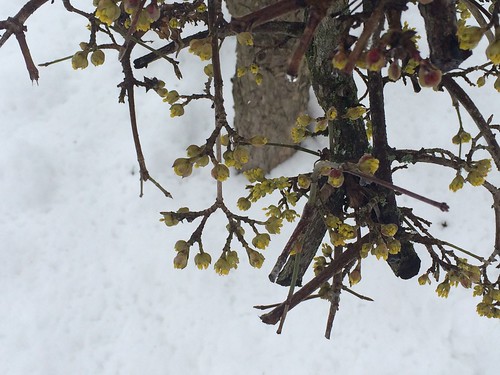To make bread, I measure malty, bubbly sourdough starter into a bowl, then pour in water to create a slurry. Time ticks. Snow covers sidewalk and car, lawn and neighbor. I add flour and salt, and watch a woman ski down the street.
She is a novice. I know this because she’s propelling herself down the street with poles alone. They swing, sink into snow, and strain to drag her body forward. Her legs? Along for the ride.
I measure flour.
Ruefully, I remember the aching overuse of underused muscle. I imagine the skier squeezing muscle ointment onto fingers, an involuntary wince triggered by biceps too sore to be touched. “If you knead the dough/ with perfect tenderness/ it’s like gently kneading flesh …” wrote poet Linda Pastan.
Now it is my turn to fold and turn dough.
Flour, water, salt, and yeast are no longer separate ingredients, intermingled yet distinguishable beneath my fingers. Water has moistened flour, which collapsed into stretchable strands of gluten. Sugars found within the flour have fed the bacteria and wild yeast in the sourdough starter. Microbes have feasted, belched, procreated, and died. As their progeny continues the lifecycle, my hands shape the bubbly, living organism. “Bread rising in the bowl/ is like breath rising in the body,” Pastan wrote.
Time transforms texture.
If the poet calls bread the “universal language, translatable on the famished tongue,” then my round loaves are requests for forgiveness. My imperfect flesh, used for 48 years, is supple and resilient. My mind, at midlife, is once again awash in hormonal flux. There is much to pardon in actions and word, and to make bread is communion with my many selves–lover and stranger, child and parent.
My hands shape a taut skin over balls of dough, which will rise one final time in darkness and heat that mimics the environment of all birth–individual and universal. Do this in memory of me. In a flash, I am a small girl, guided by God to corral siblings into playing church. Thin young arms stretch in blessing. This is my body. I place bread crumbs onto their pink tongues.
Skier is gone. Snow continues to fall. The toasted caramel smell of baked bread draws my children to the kitchen where we cut open a loaf. Steam rises from the hot slices and butter trickles through fingers. Grace goes unsaid.
The Poetry Foundation said Pastan’s quiet lyrics often address the anxieties that exist under the surface of everyday life. Her poetry touches on themes of marriage, parenting, and grief; all three appear in this poem from “Traveling Light: Poems” (2011).
“Bread”
after Lynbomir Levchev
“It seems to be the five stages
of yeast, not grief,
you like to write about,”
my son says,
meaning that bread is always rising
and falling, being broken
and eaten, in my poems.
And though he is only half serious,
I want to say to him“bread rising in the bowl
is like breath rising in the body”;
or “if you knead the dough
with perfect tenderness
it’s like gently kneading flesh
when you make love.”
Baguette … pita … pane …
challah … naan: bread is
the universal language, translatable
on the famished tongue.Now it is time to open
the package of yeast
and moisten it with water,
watching for its fizz,
its blind energy — proofing
it’s called, the animate proof
of life. Everything
is ready: salt, flour, oil.
Bread crumbs are what lead the children home.
- Linda Pastan.
- “Traveling Light: Poems” (public library).
- The chemistry of bread-making and its aroma by Compound Interest, the creation of British educator Andy Brunning whose aim is to explain the chemical compounds we come across on a day-to-day basis with easy-to-understand graphics.
- Thank you Denise Parsons from @chezdanisse for bringing Pastan to my attention via #threepoemthursdays.


That’s exactly how I ski—arms dragging stiff legs, still after 20+ years. It’s been years since I baked bread, but nothing is as good as butter melting on a hot slice, crusty on the ouside, tender inside.
Agreed!